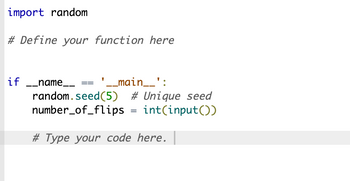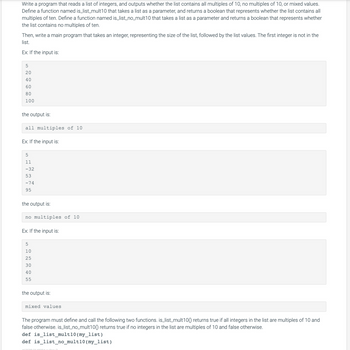
Database System Concepts
7th Edition
ISBN: 9780078022159
Author: Abraham Silberschatz Professor, Henry F. Korth, S. Sudarshan
Publisher: McGraw-Hill Education
expand_more
expand_more
format_list_bulleted
Question

Transcribed Image Text:import random
# Define your function here
if __name__
'__main__':
random.seed (5) # Unique seed
number_of_flips = int(input())
# Type your code here.

Transcribed Image Text:Write a program that reads a list of integers, and outputs whether the list contains all multiples of 10, no multiples of 10, or mixed values.
Define a function named is_list_mult10 that takes a list as a parameter, and returns a boolean that represents whether the list contains all
multiples of ten. Define a function named is_list_no_mult10 that takes a list as a parameter and returns a boolean that represents whether
the list contains no multiples of ten.
Then, write a main program that takes an integer, representing the size of the list, followed by the list values. The first integer is not in the
list.
Ex: If the input is:
5
20
40
60
80
100
the output is:
all multiples of 10
Ex: If the input is:
5
11
-32
53
-74
95
the output is:
no multiples of 10
Ex: If the input is:
5
10
25
30
40
55
the output is:
mixed values.
The program must define and call the following two functions. is_list_mult100) returns true if all integers in the list are multiples of 10 and
false otherwise. is_list_no_mult100) returns true if no integers in the list are multiples of 10 and false otherwise.
def is_list_mult10 (my_list)
def is_list_no_mult10 (my_list)
Expert Solution
This question has been solved!
Explore an expertly crafted, step-by-step solution for a thorough understanding of key concepts.
This is a popular solution
Trending nowThis is a popular solution!
Step by stepSolved in 7 steps with 4 images

Follow-up Questions
Read through expert solutions to related follow-up questions below.
Follow-up Question
did not complete the code
![1:Compare output
2:Compare output
Your output
3:Compare output
Input
5:Unit test
Your output
4:Unit test ^
Input
Input
Your output
5
20
40
60
80
100
all multiples of 10
5
11
-32
53
-74
95
no multiples of 10
5
10
25
30
40
55
mixed values
is_list_mult10([10, 200, 4000])
is_list_no_mult10([9, 11, 13])
2/2
2/2
2/2
0/2
0/2](https://content.bartleby.com/qna-images/question/993de58a-2778-4b88-a613-cf3a42e4d67b/f36f0180-5707-43cd-96ba-a7e5166aea45/s22ekcn_thumbnail.png)
Transcribed Image Text:1:Compare output
2:Compare output
Your output
3:Compare output
Input
5:Unit test
Your output
4:Unit test ^
Input
Input
Your output
5
20
40
60
80
100
all multiples of 10
5
11
-32
53
-74
95
no multiples of 10
5
10
25
30
40
55
mixed values
is_list_mult10([10, 200, 4000])
is_list_no_mult10([9, 11, 13])
2/2
2/2
2/2
0/2
0/2
Solution
by Bartleby Expert
Follow-up Questions
Read through expert solutions to related follow-up questions below.
Follow-up Question
did not complete the code
![1:Compare output
2:Compare output
Your output
3:Compare output
Input
5:Unit test
Your output
4:Unit test ^
Input
Input
Your output
5
20
40
60
80
100
all multiples of 10
5
11
-32
53
-74
95
no multiples of 10
5
10
25
30
40
55
mixed values
is_list_mult10([10, 200, 4000])
is_list_no_mult10([9, 11, 13])
2/2
2/2
2/2
0/2
0/2](https://content.bartleby.com/qna-images/question/993de58a-2778-4b88-a613-cf3a42e4d67b/f36f0180-5707-43cd-96ba-a7e5166aea45/s22ekcn_thumbnail.png)
Transcribed Image Text:1:Compare output
2:Compare output
Your output
3:Compare output
Input
5:Unit test
Your output
4:Unit test ^
Input
Input
Your output
5
20
40
60
80
100
all multiples of 10
5
11
-32
53
-74
95
no multiples of 10
5
10
25
30
40
55
mixed values
is_list_mult10([10, 200, 4000])
is_list_no_mult10([9, 11, 13])
2/2
2/2
2/2
0/2
0/2
Solution
by Bartleby Expert
Knowledge Booster
Learn more about
Need a deep-dive on the concept behind this application? Look no further. Learn more about this topic, computer-science and related others by exploring similar questions and additional content below.Similar questions
- In pythonarrow_forwardin python Write a function that receives a string containing a 32-bit hexadecimal integer. The function must return the string’s integer value. Write a function that receives an integer. The function must return a string containing the binary representation of the integer. Write a function that receives an integer. The function must return a string containing the hexadecimal representation of the integer. Write a function that adds two hexadecimal strings, each as long as 1,000 digits. Return a hexadecimal string that represents the sum of the inputs.arrow_forwardMy Birthday Function Write a well-documented Python program, hmwk4Q4.py, that simulates a single trial of a person walking into a room on N people and determining if their birthday matches any of the other N people in the room. Design a function myBirthday (N) that returns True if a match is found, or False if no match is found. Import the python random number module into your program. On a single trial, with a user input 200 people, you may not find someone with your birthday. If you manually rerun the simulation ten times, your code, however, should see that approximately four (4.22 exactly) times there is a match to your birthday.arrow_forward
- Write a function print_shampoo_instructions() with parameter num_cycles. If num_cycles is less than 1, print "Too few.". If more than 4, print "Too many.". Else, print "N : Lather and rinse." num_cycles times, where N is the cycle number, followed by "Done.".Sample output with input: 2 1: Lather and rinse. 2: Lather and rinse. Done. Hint: Define and use a loop variable. I am getting the correct output,but i can't get rid of the white space between the number and the ':' 1 : Lather and rinse. 2 : Lather and rinse. Done.arrow_forwardWrite a c++ program that includes two functions for sorting integers. your program must acts as following: Ask the user to enter 5 numbers and then by calling Asc() and Dsc() functions sort these 5 numbers in ascending and descending orders. Sample output: How many integers you wants to sort? 5 Please enter 5 integers: 5 8 -1 0 2 the ascending order of your list is: -1 0 2 5 8 The Descending order of your list is: 8 5 2 0 -1 Note: to do the above question do not use the array , vector or class. Use swaparrow_forwardDefine a function named check_game_finished (encrypted_list) which takes a list of characters as a parameter. The function returns True if the game is over, and False otherwise. The game is over when there is no longer any "*" characters in the parameter list. For example: Test Result False True data = ['h', '*', ¹*¹, ¹*¹, ¹*'] print(check_game_finished (data)) data = ['h', 'e', '1', '1', 'o'] print(check_game_finished(data)) data = ['s', ¹*¹ 'd'] False print(check_game_finished (data))arrow_forward
- Write a python program with the following functions:1. the function factorial_loop(num) that takes an integer num and returns the value of the factorial of num written as num!, where num! = num * (num-1) * (num-2) * … * 2 * 1. This function must use a loop (iteration) to compute the value of num!.2. the function factorial_recursive(num) that takes an integer num and returns the value of the factorial of num (i.e., num!) as defined above. This function must use a recursive algorithm to compute the value of num!.arrow_forwardWrite a c++ program that includes two functions for sorting integers: Ask user to enter 5 numbers and then by calling Asc() and Dsc() functions sort these 5 numbers in ascending and descending orders. Sample output: How many integers you wants to sort? 5 Please enter 5 integers: 5 8 -1 0 2 the ascending order of your list is: -1 0 2 5 8 The Descending order of your list is: 8 5 2 0 -1 Note: Do not use the array.arrow_forwardThe programming language is - Python a. Write a function called daysOver that takes three arguments: a dictionary, a location (such as ‘Sydney’, ‘Adelaide’,etc) and a temperature and returns the number of days that were over the given temperature for the given location. For example, if we call the function using the line: total = daysOver(dictionaryData, ‘Adelaide’, 40) total will hold the number of days that Adelaide had a temperature greater than 40 celsius in the data. As a test, there were 54 days over 40 celsius in the data. Check that total is 54 for the example when you run your code. b. Use the daysOver function to print the number of days over 35 celsius for each of the following cities: 'Adelaide','Perth','Melbourne','Canberra','Sydney','Brisbane','Darwin' c. Which of the Australian cities has the most number of days over 35 celsius? My spreadsheet looks like this Since I cannot attach an excel file, my excel file name is "weatherAUS.csv"arrow_forward
- -Python- Write a function get_letter_grade, such that when given * a lab grade score and * a list of the grade cutoffsreturns the letter grade of that score.Note: Your function automatically returns A for the values that are >= to the first cutoff-value in the list, then A- for the second cutoff-value, B+ for the third and so on. The function returns None for anything that's below the score for B-. You test that get_letter_grade(97, [93, 90, 87, 83, 80]) correctly returns an A, and get_letter_grade(93, [97, 90, 87, 83, 80]) returns A-. DO NOT hard-code the cutoffs, since they can change! You can copy/paste the following template: def get_letter_grade(score, cutoffs): if score ... : return 'A' ...: return 'A-' ...: return 'B+' ...: return 'B' ...: return 'B-'arrow_forwardWrite a lisp program (please provide photos that it works)arrow_forward
arrow_back_ios
arrow_forward_ios
Recommended textbooks for you
 Database System ConceptsComputer ScienceISBN:9780078022159Author:Abraham Silberschatz Professor, Henry F. Korth, S. SudarshanPublisher:McGraw-Hill Education
Database System ConceptsComputer ScienceISBN:9780078022159Author:Abraham Silberschatz Professor, Henry F. Korth, S. SudarshanPublisher:McGraw-Hill Education Starting Out with Python (4th Edition)Computer ScienceISBN:9780134444321Author:Tony GaddisPublisher:PEARSON
Starting Out with Python (4th Edition)Computer ScienceISBN:9780134444321Author:Tony GaddisPublisher:PEARSON Digital Fundamentals (11th Edition)Computer ScienceISBN:9780132737968Author:Thomas L. FloydPublisher:PEARSON
Digital Fundamentals (11th Edition)Computer ScienceISBN:9780132737968Author:Thomas L. FloydPublisher:PEARSON C How to Program (8th Edition)Computer ScienceISBN:9780133976892Author:Paul J. Deitel, Harvey DeitelPublisher:PEARSON
C How to Program (8th Edition)Computer ScienceISBN:9780133976892Author:Paul J. Deitel, Harvey DeitelPublisher:PEARSON Database Systems: Design, Implementation, & Manag...Computer ScienceISBN:9781337627900Author:Carlos Coronel, Steven MorrisPublisher:Cengage Learning
Database Systems: Design, Implementation, & Manag...Computer ScienceISBN:9781337627900Author:Carlos Coronel, Steven MorrisPublisher:Cengage Learning Programmable Logic ControllersComputer ScienceISBN:9780073373843Author:Frank D. PetruzellaPublisher:McGraw-Hill Education
Programmable Logic ControllersComputer ScienceISBN:9780073373843Author:Frank D. PetruzellaPublisher:McGraw-Hill Education

Database System Concepts
Computer Science
ISBN:9780078022159
Author:Abraham Silberschatz Professor, Henry F. Korth, S. Sudarshan
Publisher:McGraw-Hill Education

Starting Out with Python (4th Edition)
Computer Science
ISBN:9780134444321
Author:Tony Gaddis
Publisher:PEARSON

Digital Fundamentals (11th Edition)
Computer Science
ISBN:9780132737968
Author:Thomas L. Floyd
Publisher:PEARSON

C How to Program (8th Edition)
Computer Science
ISBN:9780133976892
Author:Paul J. Deitel, Harvey Deitel
Publisher:PEARSON

Database Systems: Design, Implementation, & Manag...
Computer Science
ISBN:9781337627900
Author:Carlos Coronel, Steven Morris
Publisher:Cengage Learning

Programmable Logic Controllers
Computer Science
ISBN:9780073373843
Author:Frank D. Petruzella
Publisher:McGraw-Hill Education